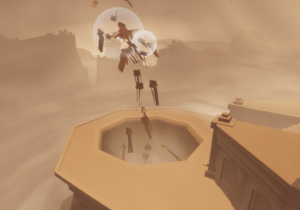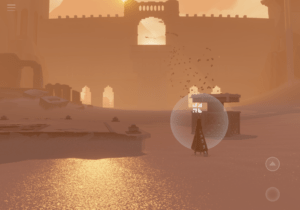Developed by Thatgamecompany, Journey is an indie adventure game where user explores a mysterious world, surrounded by desert, alone. While Journey is most recommended to be played on PlayStation or PC, it’s also available on iOS. This is a single-player game intended for any audience above age 12. For players who enjoy action-packed games, this is a space to slow down and rediscover sense of wonder; for others, this is a space for a embarking a peaceful journey. Without access to PlayStation or PC, I ended up playing Journey on my iPad when wearing AirPods for an immersive walking simulation experience.
Analysis
The music and graphic design immediately captures my attention when I enter the game. Surrounded by nothing by desert, I wondered where I am and what my mission is. The clever mechanics and level design of Journey gradually unveils the original story the developers aim to convey yet also offers enough autonomy for players to craft their own narratives.

Beginning of the game
How design contributes to embedded and emergent narratives
The game begins by placing the protagonist in the middle of a desert along with calm music. Unlike traditional games, it begins without any tutorial, leaving it for the players to explore. Due to this, the first level seems to be a playground for players to familiarize the control of the protagonist, while gradually picking up clues on what the narrative is based on. The controls are simple: you can walk, jump/fly, and communicate. By designing the protagonist without hands and only providing these simple actions, the developers force the players to focus on the sole action of walking and exploring without thinking there are additional tasks to complete, enhancing the aesthetics of discovery. The lack of username and interaction between players situates the players into an explorer mindset, implying that the objective of this game is to explore.
While it seems like there’s no end goal to the game, self-determination theory and psychological needs of information and sensual are the key intrinsic motivators for players to complete the game. As users complete each level, there’s a transition that unveils glyphs and wall arts, as if conveying the story of some fallen civilization. The mystery of these information propels users to continue through the journey to uncover the narrative, satisfying the cognizance aspect of information psychological needs. For instance, when I was playing the game, I was curious what the glyph was about and who the kite-like figures are in the middle of the journey. Despite having no dialogue, players know they’re progressing through the narrative and reaching climax as the tempo of the music increases and the scenery changes, satisfying our sentience needs of audio and visual stimulation.
In the second level, by having to repeat the same action of unlocking the red magic carpet, players experience a sense of mastery. This skill is essential for helping the kite-like flying carpets in future levels, providing players a sense of competence and psychological needs of nurturance by releasing those flying carpets from the cage. Even though those flying carpets aren’t real players, I felt sense of fellowship and relatedness when those carpets accompanied me as I’ve been exploring the desert alone for a while beforehand.


Following the kite-like carpet and unlocking them from tower.
Why people love this game
People love the game due to autonomy, both the autonomy to explore and construct their own narratives. Like the name itself, the journey is what matters in Journey. Since the world seems unbounded, each players has their own unique experiences in exploring this world. One could wonder around to observe the beautiful scene design or to focus on progressing through the levels. Without any dialogue, it creates a magic circle that withdraw players from reality and immerse in the game itself. Without using any word but only by the glyph to communicate, players have to use their own imagination to construct and interpret what the carpets are saying. For me personally, I use the small glyph as a signal to tell the carpets I’m catching up and the large one as signal for help.


Small and large glyph for communication
Improvement
While this game contains profound music and scene design for sensory pleasure, the major flaw of iOS version is its progress saving feature. Due to limited time, I couldn’t find a consecutive time to play. When I stopped half way and wanted to resume later on, the game restored to a level that I had already completed. After completing this level again, it resumed to the same level again after I stopped. Having to complete the level repeatedly ruined the emotion that built up in previous levels.
Conclusion
Overall, Journey provides an unique gaming experience that I had never experienced before. Its removal of complicated controls and dialogue allows players to focus purely on walking and rediscover curiosity of the world. The beauty of this game stems from the emergent narrative–you’re the unique adventurer on your own journey.



